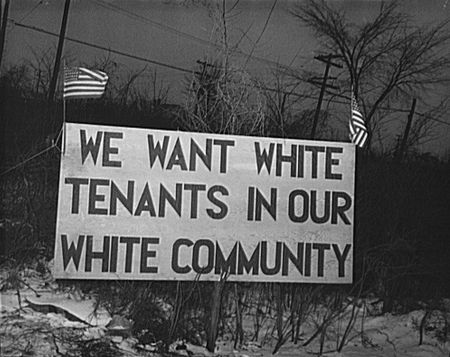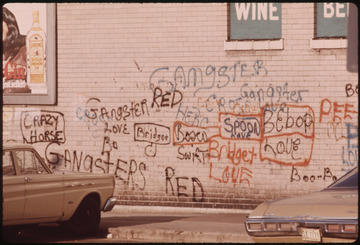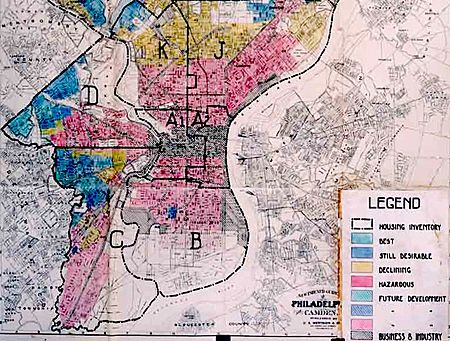American ghettos facts for kids
Ghettos in the United States are often urban neighborhoods. They are sometimes seen as areas with high crime and poverty. These areas formed in the United States because of laws and private actions. These actions aimed to separate people for political, economic, social, and even personal reasons. This separation was done both by law (de jure) and by common practice (de facto).
Even today, de facto segregation continues. This happens through things like where people live (residential segregation) and where they go to school (school segregation). This is due to how people act now and the lasting effects of past laws. American ghettos are communities where a minority group was concentrated. Also, barriers were put in place to make it hard for them to leave. The term "Inner city" is often used instead of "ghetto," but it usually means the same thing. You can see examples of American ghettos in big cities like New York City, Chicago, and Detroit.
Contents
What Are American Ghettos?
An "American ghetto" usually means a city neighborhood. It often has crime, gang activity, and a lot of poverty. Many minority citizens live there. These areas formed for many reasons. In the past, violence was sometimes used to keep certain groups in these neighborhoods. Also, when industries left inner cities, many jobs were lost. This made conditions worse and helped create ghettos.
Other problems in ghettos included a lack of jobs and extreme poverty. Dangerous streets and violence also played a part. The way housing was separated in modern times also contributed. This was due to both racism in practice (de facto) and racism by law (de jure). At first, laws caused the separation. Later, even after laws changed, the cost of living in certain areas kept black people out. Ideas like rent vouchers have been suggested to help end this separation.
How Ghettos Formed: A History
A study by Brandeis University found something important. A big reason for the wealth gap between races in America is differences in home ownership. It's hard to say exactly when housing discrimination began. This is because many types of discrimination happened at the same time. But, Jim Crow laws also affected home ownership and government housing rules.
These unfair federal and state rules, along with private fears about losing money, led to a system. This system kept minorities from getting loans and credit. It also made it harder for them to earn higher incomes. This practice was called redlining.
Redlining Explained
In 1933, a program called the Home Owners' Loan Corporation (HOLC) was created. It was part of President Roosevelt's New Deal plan. This plan aimed to help people during the Great Depression. It helped homeowners who were behind on their mortgage payments. This help usually came as loans and federal aid for over 25 years.
President Roosevelt also signed the National Housing Act of 1934 (NHA). This act created the Federal Housing Administration (FHA). This government policy made conditions worse in minority inner-city neighborhoods. It did this by holding back money for mortgages. This made it very hard for families to buy homes in these areas. The ideas behind redlining led to a big increase in racial segregation and urban decay in the United States.
The HOLC, working with the FHA, sent people to cities. They talked to local banks and city officials. Their goal was to figure out how risky it was to lend money in different neighborhoods. They looked at many things. Where was the city located? Was it near a park or factories? How old were the homes? Were there good roads, schools, and jobs? They also looked at the people living there. Was it mostly a minority neighborhood? Were people poor or uneducated?
All these things helped decide if an area was good for FHA loans or a "hazardous" zone. They used color-coded maps to show these findings.
- Green meant the best place for loans.
- Blue meant a very good place.
- Yellow meant an area that was getting worse.
- Red meant a "Hazardous" zone.
This was called the "Residential Security" map. Areas marked red had to pay higher interest rates. It was also very hard for them to get FHA loans.
| CITY | HAZARDOUS (Percentage) |
|---|---|
| Macon, GA | 64.99% |
| Augusta, GA | 58.70% |
| Flint, MI | 54.19% |
| Springfield, MO | 60.19% |
| Montgomery, AL | 53.11% |
Most people living in the red zones were black and other minorities. Poverty in black communities grew a lot because of fewer jobs and less government help. Getting credit depended on what you owned and where you lived. This automatically disqualified most black people and minorities. They were often living in run-down areas. Many middle-class black people tried to move to the industrial Midwest and Northeast. They hoped for better jobs and to leave the red zones. But, clear rules against black people kept them from finding homes outside these zones.
Even where there were no specific exclusion laws, real estate agents created fear. They warned that black people moving in would turn white communities into red zones. This led to "white flight." This is when white families moved out of the inner city to the suburbs. It also led to "blockbusting" in the 1960s and 70s. Minorities kept moving into the red zones because they couldn't afford to live anywhere else. Higher taxes and prices on homes in these red zones made the neighborhoods constantly lose value.
The government also encouraged white families to move to suburbs by giving them loans. At the same time, they destroyed many established African American communities. They did this by building elevated highways right through their neighborhoods. To build these highways, thousands of homes were torn down. Because these homes were called "in decline," families were paid very little for their properties. They were then forced to move into government housing called "the projects." To build these projects, even more homes were destroyed.
Segregation That Still Happens (De Facto)
Congress has passed laws to end segregation by law (de jure). However, segregation that happens in practice (de facto) still exists. This is true in American schools and cities. People have the right to choose where they live. Because of cultural, economic, social, and personal reasons, people sometimes choose to live with others like themselves. This is called self-segregation.
Some white families wanted to avoid having their children go to integrated schools. This was a reason for "white flight" to the suburbs. It also led to many private schools being started. Most African-American students could not afford these schools, even if they were technically allowed to attend. Studies in San Francisco showed that groups of homeowners tended to live near people with similar education levels and races.
By 1990, the legal rules enforcing segregation were mostly gone. But other things caused separation. For example, white people sometimes paid more than black people to live in mostly white areas. When white people are separated from black people in the United States, it affects how they grow up. It limits their chances to form real friendships with black people and other minorities. This separation can lead white people to have positive views about themselves and negative views about black people.
Important Supreme Court Cases
The Supreme Court made several important decisions about housing rights and segregation.
Buchanan v. Warley
In the case of Buchanan v. Warley, the Supreme Court looked at a city rule. This rule limited who could buy homes. It stopped black people from buying in areas where most white people lived. It also stopped white people from buying in areas where most black people lived. Over time, this rule made racial separation much worse. It forced minority groups into certain areas.
The Supreme Court decided that this rule from Louisville, Kentucky, was against the law. They said it violated the freedom to make contracts, which is protected by the 14th Amendment. This meant cities could not make rules that restricted housing based on race.
Corrigan v. Buckley
The case of Corrigan v. Buckley was different from Buchanan v. Warley. It didn't deal with city rules. Instead, it allowed neighborhoods to make private agreements that discriminated based on race. These were called "racially discriminatory covenants." The Supreme Court ruled that neighborhoods could make these agreements. They also said that the government could enforce them. The Court said these were private contracts, so the government couldn't control them. Sadly, because of this case, these unfair agreements spread across the United States. This led to even more segregated housing.
Hansberry v. Lee
In Hansberry v. Lee, the Supreme Court made a ruling about a previous case. That case was about racially exclusive agreements in a Chicago neighborhood. The Court said that many people affected by the agreements were not properly represented in the first case. Because of this, the case could be argued again. This decision was important for a legal idea called res judicata. It also opened the door for the case of Shelley v. Kraemer.
Shelley v. Kraemer
Shelley v. Kraemer was a very important case for housing rights in America. The Supreme Court of Missouri had said that racially exclusive agreements were just private contracts. But the U.S. Supreme Court disagreed. They ruled that these agreements violated the equal protection clause of the Constitution. This means everyone should be treated equally under the law. The decision was 6-0. Three judges did not vote because they lived in neighborhoods with these types of agreements. This ruling made racially exclusive agreements illegal.
See Also
- Residential segregation in the United States
- Racial segregation in the United States
- White flight
- Blockbusting





